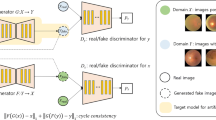Abstract
In low-cost wide-field fundus cameras, the built-in lighting sources are prone to generate stray-light nearby, leading to low-quality image regions. To visualize retinal structures clearer, when fusing two images with complementary patterns of different lighting sources, the fused image might still have stray-light phenomenon near the hard fusing boundaries, i.e., typically in the diagonal directions. In this paper, an image enhancement algorithm based on generative adversarial network is proposed to eliminate the stray-light in wide-field fundus fusing images. First, a haze density estimation module is introduced to guide the model to pay attention to more serious stray-light regions. Second, a detail recovery module is introduced to reduce the loss of details caused by stray-light. Finally, a domain discriminator with unsupervised domain adaptation is employed to achieve better performance generalization on clinical data. Experiments show that our method obtains the best results on both public synthesized traditional fundus image dataset EyePACS-K and private wide-field fundus images dataset Retivue. Compared to the SOTA, the PSNR and Structural Similarity on average upon two above datasets are increased by 1.789 dB and 0.021 respectively.
Access this chapter
Tax calculation will be finalised at checkout
Purchases are for personal use only
Similar content being viewed by others
References
Bai, X., Zhou, F., Xue, B.: Image enhancement using multi scale image features extracted by top-hat transform. Opt. Laser Technol. 44(2), 328–336 (2012)
Cai, B., Xu, X., Jia, K., Qing, C., Tao, D.: DehazeNet: an end-to-end system for single image haze removal. IEEE Trans. Image Process. 25(11), 5187–5198 (2016)
Cao, L., Li, H., Zhang, Y.: Retinal image enhancement using low-pass filtering and \(\alpha \)-rooting. Signal Process. 170, 107445 (2020)
Cheng, P., Lin, L., Huang, Y., Lyu, J., Tang, X.: I-SECRET: importance-guided fundus image enhancement via semi-supervised contrastive constraining. In: de Bruijne, M., et al. (eds.) MICCAI 2021. LNCS, vol. 12908, pp. 87–96. Springer, Cham (2021). https://doi.org/10.1007/978-3-030-87237-3_9
Fu, H., et al.: Evaluation of retinal image quality assessment networks in different color-spaces. In: Shen, D., et al. (eds.) MICCAI 2019. LNCS, vol. 11764, pp. 48–56. Springer, Cham (2019). https://doi.org/10.1007/978-3-030-32239-7_6
Goodfellow, I., et al.: Generative adversarial nets. In: Advances in Neural Information Processing Systems 27 (2014)
He, K., Sun, J., Tang, X.: Single image haze removal using dark channel prior. IEEE Trans. Pattern Anal. Mach. Intell. 33(12), 2341–2353 (2010)
Hore, A., Ziou, D.: Image quality metrics: PSNR vs. SSIM. In: 20th International Conference on Pattern Recognition, pp. 2366–2369. IEEE (2010)
Isola, P., Zhu, J.Y., Zhou, T., Efros, A.A.: Image-to-image translation with conditional adversarial networks. In: Proceedings of the IEEE Conference on Computer Vision and Pattern Recognition, pp. 1125–1134 (2017)
Lee, K.G., Song, S.J., Lee, S., Yu, H.G., Kim, D.I., Lee, K.M.: A deep learning-based framework for retinal fundus image enhancement. PLoS ONE 18(3), e0282416 (2023)
Li, H., et al.: An annotation-free restoration network for cataractous fundus images. IEEE Trans. Med. Imaging 41(7), 1699–1710 (2022)
Mittal, A., Soundararajan, R., Bovik, A.C.: Making a ąřcompletely blindąś image quality analyzer. IEEE Signal Process. Lett. 20(3), 209–212 (2012)
Peli, E., Peli, T.: Restoration of retinal images obtained through cataracts. IEEE Trans. Med. Imaging 8(4), 401–406 (1989)
Qian, R., Tan, R.T., Yang, W., Su, J., Liu, J.: Attentive generative adversarial network for raindrop removal from a single image. In: Proceedings of the IEEE Conference on Computer Vision and Pattern Recognition, pp. 2482–2491 (2018)
Reza, A.M.: Realization of the contrast limited adaptive histogram equalization (CLAHE) for real-time image enhancement. J. VLSI Signal Process. Syst. Signal Image Video Technol. 38, 35–44 (2004)
Shen, Z., Fu, H., Shen, J., Shao, L.: Modeling and enhancing low-quality retinal fundus images. IEEE Trans. Med. Imaging 40(3), 996–1006 (2020)
Simonyan, K., Zisserman, A.: Very deep convolutional networks for large-scale image recognition. arXiv preprint arXiv:1409.1556 (2014)
Wang, Z., Bovik, A.C., Sheikh, H.R., Simoncelli, E.P.: Image quality assessment: from error visibility to structural similarity. IEEE Trans. Image Process. 13(4), 600–612 (2004)
Wu, J., et al.: Template mask based image fusion built-in algorithm for wide field fundus cameras. In: Antony, B., Fu, H., Lee, C.S., MacGillivray, T., Xu, Y., Zheng, Y. (eds.) OMIA 2022. LNCS, vol. 13576, pp. 173–182. Springer, Cham (2022). https://doi.org/10.1007/978-3-031-16525-2_18
Xiong, L., Li, H., Xu, L.: An enhancement method for color retinal images based on image formation model. Comput. Methods Programs Biomed. 143, 137–150 (2017)
Yang, B., Zhao, H., Cao, L., Liu, H., Wang, N., Li, H.: Retinal image enhancement with artifact reduction and structure retention. Pattern Recogn. 133, 108968 (2023)
Yang, Y., Wang, C., Liu, R., Zhang, L., Guo, X., Tao, D.: Self-augmented unpaired image dehazing via density and depth decomposition. In: Proceedings of the IEEE/CVF Conference on Computer Vision and Pattern Recognition, pp. 2037–2046 (2022)
Yao, L., Lin, Y., Muhammad, S.: An improved multi-scale image enhancement method based on Retinex theory. J. Med. Imaging Health Inform. 8(1), 122–126 (2018)
You, Q., Wan, C., Sun, J., Shen, J., Ye, H., Yu, Q.: Fundus image enhancement method based on CycleGAN. In: 41st Annual International Conference of the IEEE Engineering in Medicine and Biology Society (EMBC), pp. 4500–4503. IEEE (2019)
Zhu, J.Y., Park, T., Isola, P., Efros, A.A.: Unpaired image-to-image translation using cycle-consistent adversarial networks. In: Proceedings of the IEEE International Conference on Computer Vision, pp. 2223–2232 (2017)
Acknowledgement
This work is supported by Xinjiang Production and Construction Corps Science and Technology Project, Science and Technology Development Program in Major Fields (2022AB021), and National High Level Hospital Clinical Research Funding (BJ-2022-120, BJ-2023-104).
Author information
Authors and Affiliations
Corresponding author
Editor information
Editors and Affiliations
Rights and permissions
Copyright information
© 2024 The Author(s), under exclusive license to Springer Nature Switzerland AG
About this paper
Cite this paper
Wu, J., He, M., Liu, Y., Lin, J., Huang, Z., Ding, D. (2024). Removing Stray-Light for Wild-Field Fundus Image Fusion Based on Large Generative Models. In: Rudinac, S., et al. MultiMedia Modeling. MMM 2024. Lecture Notes in Computer Science, vol 14557. Springer, Cham. https://doi.org/10.1007/978-3-031-53302-0_1
Download citation
DOI: https://doi.org/10.1007/978-3-031-53302-0_1
Published:
Publisher Name: Springer, Cham
Print ISBN: 978-3-031-53301-3
Online ISBN: 978-3-031-53302-0
eBook Packages: Computer ScienceComputer Science (R0)




